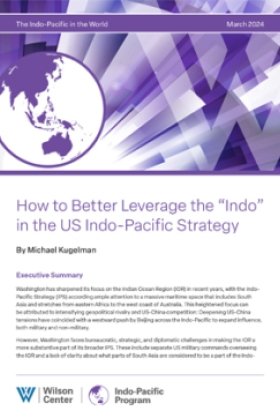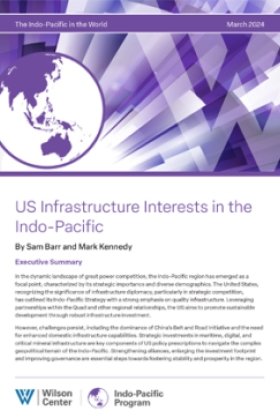Running on Empty: Pakistan's Water Crisis
Arid yet dependent upon agriculture, Pakistan is experiencing a potentially devastating water crisis. An expert panel assembled by the Wilson Center's Asia Program presented the different facets of the crisis, from scarcity to sanitation to inefficient usage, and examined possible responses.
"Water shortages," warns the British scholar Anatol Lieven, "present the greatest future threat to the viability of Pakistan as a state and a society." While this assertion may be overblown, one can hardly dispute its underlying premise: Pakistan's water situation is extremely precarious. Water availability has plummeted from about 5,000 cubic meters per capita in the early 1950s to less than 1,500 cubic meters per capita today. Presently, more than 90 percent of these dwindling water resources are used for irrigation and other agricultural needs—not a surprise, given that Pakistan is an overwhelmingly arid country with an agriculture-dependent economy.
On November 20, the Asia Program, with assistance from the Environmental Change and Security Program and the Comparative Urban Studies Project, and with financial support from the Fellowship Fund for Pakistan, convened a conference to highlight the different facets of Pakistan's water crisis; to examine the rural and urban dimensions of the crisis; and to consider possible responses.
In her opening address, the Hisaar Foundation's Simi Sadaf Kamal provided a comprehensive overview of Pakistan's water challenges. These include inefficient irrigation, abysmal urban sanitation facilities, unequal water rights—and the country's rapidly disappearing water resources. Kamal pointed out that parts of the Indus River Basin—Pakistan's major water source—are drying up. Quetta, the largest city in Balochistan Province, may have "no water supply" within five to seven years. Various factors—such as a growing population, rising demand, and snow and ice reductions in the Himalayas—account for these shortages. So what can be done? All too often, Kamal said, purported solutions for Pakistan's water shortages simply call for more water. Yet there is never any talk about "where this water will come from." Furthermore, Islamabad's expenditures on water supply and sanitation amount to less than 0.2 percent of GDP. Kamal declared that, given these supply-side realities, Pakistan must shift its emphasis from water supply management to water demand management—and focus on reducing water demand.
The morning panel took a closer look at the water crisis in Pakistan's countryside. Feisal Khan of Hobart and William Smith Colleges described how poor state policies and governance as well as corruption have affected irrigation. One ill-advised policy has been "systematic underinvestment" in irrigation infrastructure. Insufficient monies are spent on infrastructural maintenance, leading to neglect and underperformance. Bad governance is illustrated by the "de facto collapse" of warabandi, a rotational system used for the equitable allocation of irrigation water in Pakistan and northern India for more than 130 years. Finally, corruption runs rampant; according to one source with whom Khan has consulted, government irrigation officials in the provinces of Punjab and Sindh are "horribly corrupt, inefficient, and bloody lazy," and farmers freely admit to bribing them. Ending such practices, Khan concluded, may require a thorough "recentralization and reprofessionalization" of Pakistan's "irrigation bureaucracy."
Sarah J. Halvorson of the University of Montana traced the intersections of water, gender, and health in rural Pakistan. Access to water is of paramount importance for Pakistani women, because women bear primary responsibility for completing water-related tasks and for obtaining the water needed to undertake these activities. Halvorson noted that the challenges of securing water in rural Pakistan have grown since the 2005 Kashmir earthquake, which displaced mountain residents and forced them into tent villages. Furthermore, Pakistani rural women face "an unprecedented crisis" in water and sanitation—from unsafe drinking water to water-borne disease. While acknowledging the "constraints" to improving rural women's access to water—from micro-level issues like illiteracy to macro factors such as climate change—Halvorson asserted that women's perspectives are increasingly being incorporated into the country's water debates. All the same, she concluded, Pakistan must apply gender analysis to water vulnerability assessments.
The Acumen Fund's Adrien Couton discussed the Fund's Pakistan-based investments in drip irrigation, a system that conveys a small but continuous supply of water to plants. Today, these investments serve more than 130,000 households in the Thar Desert of Sindh Province. Couton argued that the advantages of drip irrigation are particularly attractive for policymakers. The system is "granular," meaning that—unlike in the case of a dam—drip irrigation investments can easily be distributed throughout different parts of the country and over time. Additionally, water-saving drip irrigation communicates a "strong message" that water is indeed scarce and precious in Pakistan. Finally, the system enhances crop productivity: Drip irrigation, according to Couton, enables farmers to irrigate several different crops at once and yields high-value products.
The luncheon speaker, Kaiser Bengali of the Pakistan government's Benazir Income Support Programme, warned that Pakistan will not be able to address its water crisis without a paradigm shift in the way in which Pakistanis think about water management. The old paradigm, Bengali observed, is overwhelmingly "techno-centric" and emphasizes engineering solutions and water storage. This approach is increasingly inadequate because of shortfalls both in the supply of water and in funds required for operation and maintenance and for investment. These constraints require a new "socio-centric" strategy that places greater reliance on indigenous physical and human resource management and is more "resource-efficient and ecologically conducive." What does this mean in practice? Pakistan must move from "a fetish" with the expansion of water supplies through water storage (i.e., dams) to a new emphasis on the conservation of limited water resources. It must shift away from large-scale capital- and technology-intensive, environmentally degrading solutions to a management-intensive, ecologically balanced approach that relies on indigenous technology.
The afternoon panel featured three speakers addressing aspects of the water crisis in Pakistan's cities. MIT's James L. Wescoat Jr. noted that Karachi, Pakistan's largest city, has often had a reliable supply of water for only four hours a day, and asked what a water-conserving design for Pakistan would actually look like. Rainwater harvesting, constructed wetlands, advanced pond and lagoon systems, and a new emphasis on water-use efficiency must all be part of the solution, he posited. There is reason for optimism, he added; some of the world's most sophisticated research in environmental design is being done in Pakistan.
Cal State's Anita Chaudhry shifted the focus to Lahore, Pakistan's cultural and intellectual capital, and considered what would be required to secure sustainable access to safe drinking water in that city. Lahore, unlike most cities, relies exclusively on groundwater, most of which sits 300-600 feet below the surface. Groundwater levels have dropped by 10 feet in just the past five years, Chaudhry warned. Moreover, for the past four years, 100 percent of Lahore's groundwater samples have contained major contaminants beyond permissible limits. Pakistanis, she concluded, must pay far more attention to sustaining a balance between agricultural and urban users of water, between rich and poor consumers, and between the water needs of the current generation and those of the future. The rapid depletion of groundwater supplies, she added, is essentially a tax on generations yet unborn.
Samia Altaf, the Wilson Center's current Pakistan Scholar, concentrated on some of the public health aspects of the water crisis. Altaf argued that Pakistan's failure to provide its citizens with safe drinking water has not been due to a lack of financial resources. The international donor community, she noted, has allocated large sums of money for this purpose in recent decades, but the results have been negligible. What is needed, she contended, is a strong domestic lobby for safe water and sanitation reform, as took place in Europe and the United States in the 19th century. She pointed to more recent successes—banning tobacco advertising and persuading automobile passengers to use seat belts—as other examples where state action and a mobilized civil society can wield a considerable influence on public safety issues. What have been lacking in Pakistan, she concluded, are accountability and an engaged citizenry.
Throughout the day, speakers underscored the tremendous challenges standing in the way of resolving Pakistan's water crisis. Yet it is notable that for all the weighty talk about necessary "paradigm shifts," a number of practical and relatively simple suggestions also emerged from the conference discussions. These ideas included reducing irrigation water through the use of water-conserving agricultural technology; pursuing water-conserving building design methods in urban areas; and diversifying Pakistan's water portfolio by harvesting rainwater. The implication is that realistic options do exist for easing the severity of the water crisis.
Related Programs

Indo-Pacific Program
The Indo-Pacific Program promotes policy debate and intellectual discussions on US interests in the Asia-Pacific as well as political, economic, security, and social issues relating to the world’s most populous and economically dynamic region. Read more

Environmental Change and Security Program
The Environmental Change and Security Program (ECSP) explores the connections between environmental change, health, and population dynamics and their links to conflict, human insecurity, and foreign policy. Read more










